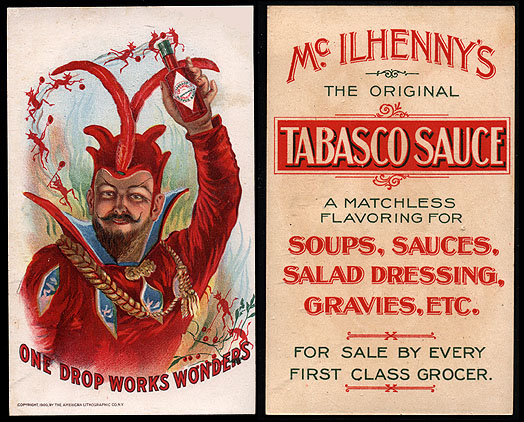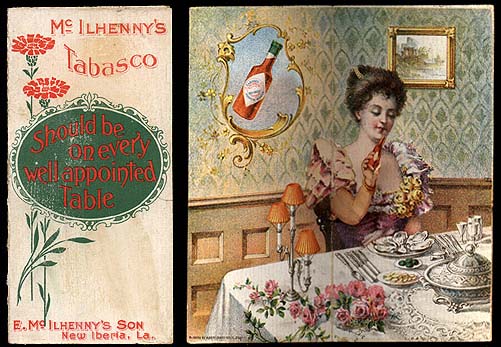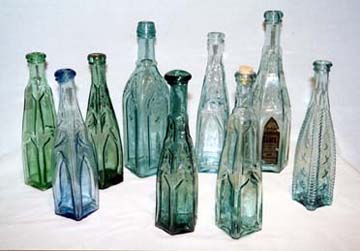|
Chuck Evans' MONTEZUMA Brand Sauces & Salsas http://montezumabrand.com/articles/the-real-history-of-tabasco/ Export date: Fri Apr 25 5:15:31 2025 / +0000 GMT |
|
The Real History of Tabasco®The Historical Record of the 1st Louisiana Tabasco Hot Sauce Manufacturer: With Evidence of the Earliest Bottled Cayenne & Bird Pepper Sauces in the United StatesCaptain Maunsel Whites Direct Connection to Edmund McIlhenny, Founder of Avery Islands McIlhenny Company & the Tabasco® BrandBy Chuck Evans
Setting the Stage-The War of 1812 Maunsel White (1783-1863) was born near Limerick, Ireland and orphaned at age six. He arrived in America at age thirteen and lived in Plaquemines Parish, Louisiana. However, little is known about his life until he joined the New Orleans militia. Maunsel White (1783-1863) was born near Limerick, Ireland and orphaned at age six. He arrived in America at age thirteen and lived in Plaquemines Parish, Louisiana. However, little is known about his life until he joined the New Orleans militia.In 1814, Captain Maunsel White, at the age of 31, was placed in charge of a white mens militia regiment, named the Louisiana Blues, under the command of Major Jean Baptiste Plauch, who reported directly to Major General Andrew Jackson, commander of the Seventh Military District and the United States forces in the Gulf campaign against Britains blockade of American ports. General Jackson was later elected President of the United States in 1828.[1] Major Plauch headed the New Orleans uniformed militia companies totaling two hundred and eighty-seven men.[2]Each of the four companies had its own distinctive, colorful uniform, and many of their members had previous military experience in France, Saint-Domingue (Haiti), and Latin America. A certain Captain Dudley Avery (d.1816), a physician from Baton Rouge, served as a medical officer in a regiment of uniformed militia during the battle of New Orleans and continued to write accounts of the conflict.[3]Captain Dudley Avery and Captain Maunsel White served in the same New Orleans uniformed militia regiment. Between 1814 and 1816, Captain Dudley Avery wrote numerous letters to Mary Ann Browne Avery, the parents of Daniel Dudley Avery (1810-1879), from New Orleans where he also served as a member of the state legislature. In 1813, Captain Dudley Avery was appointed justice of the peace in East Baton Rouge Parish. In his letters of 1814, Captain Dudley Avery mentioned General Jackson, the progress of the war, and some of the discussions in the legislature. In December 1814, Captain Dudley Avery wrote about the troops that were in New Orleans, their expectation of being attacked, and later, that the enemy had landed and two battles had taken place. At the time of the Battle of New Orleans, detachments composed of United States army troops came from Kentucky, Tennessee, Mississippi, and Louisiana militia; Baratarian pirates; Choctaw warriors; and free black soldiers. Major General Andrew Jackson defeated overwhelming British forces in 1815 in Americas first military victory. Louisianans contributed to the American victory in many ways. Behind the front lines white and free black men forty-five years and older formed home guards to protect private property and maintain order in New Orleans and surrounding towns and posts. Slaves and citizens helped widen canals and build defenses along them. The New Basin Canal was built by Irish immigrants beginning in 1832 and opening for traffic in 1838. Slaves also fortified military positions and fought in several battles of the Louisiana campaign. Women at home made clothing for the troops and flags and bandages for the militia regiments, while nuns and free women of color nursed the wounded at hospitals and convents. [4] After the Battle of New Orleans, now-Colonel Maunsel White became active in mercantile activities as a commission merchant and forwarding merchant.[5] Due to his extensive wartime contacts, Maunsel White was appointed a New Orleans commissioner. The New Orleans Canal and Banking Company, which owned and built the New Basin Canal, was founded by Maunsel White.[6] Financially, the canal was a success serving as a transport to downtown New Orleans and opening up trade with communities north of Lake Pontchartrain and cities along the Gulf of Mexico. Maunsel White invested heavily as a sugar cane farmer, receiving U.S. Patent No. 1,326 on September 17, 1839 for an evaporating pan in setting and arranging sugar kettles. Maunsel White also marketed cotton grown from his war contacts, including General John Coffee from Tennessee, the subsequent Surveyor General of Mississippi Territory & Alabama Lands, who also served under General Jackson.[7] Maunsel White operated his Deer Range plantation growing sugar cane, corn, and other crops. In 1858, his son Maunsell White, Jr. (1835-1883) purchased Junior Place, formerly the Velasco Plantation. Maunsel White and his eldest son kept extensive plantation records, including a set of plantation journals from 1852-1883 documenting the operation of the Whites plantations; diaries of his agricultural pursuits and economic conditions, including New Orleans business news, crop predictions, and cotton shipments. Also included are a set of autograph books and letters of correspondence with Andrew Jackson, Zachary Taylor, and letters written to his eldest son, who attended Mandeville College near Baton Rouge as well as the University of Virginia. These records are documented in the Inventory of the Maunsel White Papers, 1802-1912, Collection Number 2234, at the Manuscripts Department of the University of North Carolina at Chapel Hill.
In 1846 legislators voted to move the site of the state capital from New Orleans to Baton Rouge. Colonel Maunsel White was appointed as one of three statehouse commissioners to over see building the new capitol. Before building began, Baton Rouge General Assemblyman Daniel Dudley Avery replaced one of the commissioners.[8] Lawyer, representative to the General Assembly from Baton Rouge, and eventual Judge Daniel Avery, who was also joint owner of the Petit Anse Island sugar plantation, and Deer Range sugar plantation owner Maunsel White, became colleagues. The Lore of Red PeppersOf special interest in the Maunsel White Papers is a letter of 13 June 1847 in which Maunsel White described the reception of returning Mexican-American war heroes in New Orleans. The war arose from the competing claims to Texas by Mexico and the United States in the wake of the Mexican Revolution. Texas had just fought a war of independence against Mexico, which considered Texas a "breakaway province" and refused to recognize its independence. The root causes of war were westward expansion on the part of Americans and political instability in Mexico in the aftermath of the Mexican War of Independence which had made it difficult for the United States to negotiate with Mexico and for Mexico to administer its northern territories. American troops entered Mexico City where the Mexican-American War ended in 1848 establishing the southern borders of the United States, where the subsequent Treaty of Guadalupe Hidalgo resulted in the United States purchase of Mexicos northern territories. American soldiers fighting in the Mexican-American war returned to New Orleans from Vera Cruz[9] (Veracruz) which port city is just north of an area of Mexico known as the Tabasco region (which is now a state in Mexico). According to a series of articles from the Metropolitan News-Enterprise and conversation with the great-great grandson bearing the same name of Maunsel White; The New Orleans Daily Delta published an article about Colonel White's new enterprise on January 26, 1850: Col. White has introduced the celebrated tobasco red pepper, the very strongest of all peppers, of which he cultivated a large quantity with the view of supplying his neighbors, and diffusing it throughout the state. The article reports: Owing to its oleaginous character, Col. White found it impossible to preserve it by drying; but by pouring strong vinegar on it after boiling, he has made a sauce or pepper decoction of it, which possesses in a most concentrated form all the quantities of the vegetable. A single drop of the sauce will flavor a whole plate of soup or other food. The use of a decoction like this, particularly in preparing the food for laboring persons, would be exceedingly beneficial in a relaxing climate like this. Col. White has not had a single case of cholera among his large gang of negroes since the disease appeared in the south. He attributes this to the free use of this valuable agent.[10] 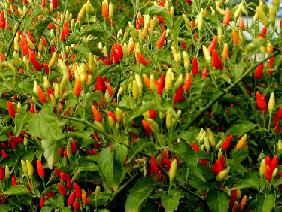 Maunsel White is likely to have come by the tobasco [sic] pepper from American soldiers returning from Vera Cruz to the celebration in New Orleans. The simple explanation is that American soldiers, exposed to the foreign produce and foodstuffs in a distant land where many would be returning to farming and agricultural pursuits after their service, would be interested in crops that they have seen and tasted in the mercados (marketplaces), and especially the abundance of vegetables, herbs, and spices for sale in the marketplaces of the cities of Monterrey and Vera Cruz, and in the cavernous Mercado Tlatelolco in Mexico City. Where Maunsel White participated in the celebrations as a city official, it is not difficult to imagine, and certainly fits logically within the time frame that Maunsel White sauce was first concocted (which is dated by two different accounts to have been either 1849 or 1850) that the alleged traveler from Central America story perpetuated in McIlhenny family lore was actually a soldier returning through the port of New Orleans from the Mexican-American war to a festive reception in June of 1847, being honored and greeted by a prominent former military officer who was also a city commissioner. Returning soldiers often waited several weeks in the port of Vera Cruz for a vessel to set sail for New Orleans, therefore, it is likely that all manner of pocket souvenirs including trinkets and clothing, spices and produce, were transported back to the states.  According to McIlhenny family tradition, the story passed down from Tabasco sauce founder, Edmund McIlhenny (1815-1890), is that he obtained some red pepper seeds from a Central American traveler who recently arrived in Louisiana. According to McIlhenny family tradition, the story passed down from Tabasco sauce founder, Edmund McIlhenny (1815-1890), is that he obtained some red pepper seeds from a Central American traveler who recently arrived in Louisiana.Another version of the story related by Edmund McIlhenny, Jr. was that a certain friend, Gleason, a soldier in the Mexican-American War, brought seed to his friend Edmund McIlhenny.[11] However, while this event may have occurred, it is more likely that a soldier in the Mexican-American War gave Maunsel White tobasco seed.[12] In 1849 Maunsel White was growing tobasco peppers at Deer Range Plantation long before Edmund McIlhenny began growing tabasco peppers on Petit Anse Island Plantation, the salt dome whose name was later changed to Avery Island. Edmund McIlhenny did not even live on the Avery plantation until 1860, after his marriage to Mary Eliza Avery in 1859, and there is no record or belief that he grew his tabasco peppers anywhere else. Further, there is a significant gap in time in McIlhenny family lore where the Mexican-American War ended in 1848 and when Edmund McIlhenny planted his first tabasco chile crop. Edmund had arrived in New Orleans only seven years prior and during that time as a Crescent City banker was busy establishing his five banks. It was only during the Reconstruction period, where the McIlhennys and Averys were financially struggling that the Avery plantation was of significant economic importance to their survival. Marsh-Avery Ownership History of Isle Petit AnseThe massive salt dome that towers over flat marshland surrounded by the Bayou Petit Anse[13]in the heart of Louisianas Cajun country seven miles south of New Iberia was purchased by John C. Marsh (1789-1857) on or about 1818. John Marsh was assisted by his second son, George Marsh (d.1859) in operating the islands sugar plantation. In 1849, John Marsh sold his interest to two of his sons-in-law, Daniel Dudley Avery (1810-1879), married to Sarah Craig Marsh (1818-1878) and Ashbel Burnham Henshaw. In 1854, Daniel Avery bought out the interest of Ashbel Henshaw, owning outright what is now known as Avery Island. In 1859, Mary Eliza Avery, daughter of Daniel Dudley Avery and Sarah Craig Marsh, married Edmund McIlhenny who was at that time a prominent Crescent City banker. Deciding that it was best to avoid the conflict of the Civil War, the Avery family and the newly-wedded McIlhennys settled in at the Avery sugar plantation on Petit Anse Island, located 140 miles west of New Orleans. However, Isle Petit Anses salt deposits became a primary focal point of war efforts in the tug-of-war between the North and the South where salt was a vital commodity for civilian and military uses. The families fled to Texas to avoid the battles. Returning in 1865 the plantation was in shambles and over the next few years negotiations took place with former slaves returning to work the plantation. Reconstruction efforts took their toll as did Mother Nature. In 1872, the cisterns ran dry in New Iberia due to a drought and water was sold on the streets. From 1873 through the end of 1876, the Averys were involved in a legal battle to retain their property where Daniel Avery was in debt to the estate of David Hayes with mortgage notes due in January 1873. Daniel was unable to raise the money to pay the notes and his wife Sarah obtained a judgment against him in 1876 to protect her part of the property (Marsh estate). Petit Anse Island was sold at auction in 1876 where a friend purchased it for a very low price and sold it back to the Averys who regained control of the plantation. Sarah Marsh Avery died suddenly in April, 1878 and Daniel Dudley Avery followed in June, 1879. Numerous documents relating to the fortunes of the Averys after the Civil War address the chief topic of the salt mines on Petit Anse Island and the familys attempts to make a successful enterprise from salt mining.[14] According to geological reports, the salt deposit was extremely valuable; however, correspondence between Daniel Dudley Avery in New Orleans, and his son John Marsh Avery, indicates the difficulty the Averys had in obtaining capital to mine the salt, as well as the growing indebtedness of the Avery family members. Edmund McIlhennys banks were gone with the winds of change in the South and he was also looking for a way to reconstruct a livelihood. When the McIlhennys and Averys fled Isle Petit Anse during the Civil War to Houston, Texas, it is alleged that upon their return in April 1865 that the sole remaining item was a crop of tabasco peppers. In another twist on the same story relating to the importance of the tabasco pepper crop, Edmund attempted to resume his banking career in New Orleans. The story[15]continues: "That failed, but during the trip an unknown man gave him some pepper seeds. He returned to Avery Island, planted the seeds, and began experimenting with a pepper sauce out of career desperation and a dislike of bland food." Once again family legend appears to be an undocumented recollection, for Edmund could not have grown a crop in 1863 before fleeing to Texas whereupon after returning to Louisiana in April of 1865, in an unsuccessful attempt to revive his banking career, he then planted seeds given to him upon his return. And lest we not forget about the traveler stories . . . were not the seeds given to Edmund McIlhenny on or about 1848 at the conclusion of the Mexican-American War where Edmund grew them in his wifes garden on the Island, however, where he did not raise them commercially for another twenty years? This summarization certainly does not reflect Edmunds 1859 marriage to Mary Eliza Avery and their move to Avery Island accurately, for the timeline does not provide a twenty year window between 1859 and 1868 when Edmunds first commercial crop reached maturity. The McIlhenny Company is beginning to publicly recognize the inconsistencies of its history attributable to family legend. "The collection of documents and artifacts relating to Tabasco sauce history has been a huge undertaking, said Dr. Shane K. Bernard, historian and curator to McIlhenny Company. Ive found items of considerable value in attics, in warehouses, and in other archives and museums around the world. And while reviewing this material I discovered inconsistencies concerning such basic topics in the history of Tabasco sauce as the origin of peppers that Edmund McIlhenny used to concoct his product, and the early reception of that product by the general consuming public." Exactly how the Mexican red pepper seeds arrived from the area of Tabasco, Mexico, which peppers were referred to as Mexican or Chili peppers, and actually ended up in the soil of Whites Deer Range Plantation in Plaquemines Parish and in the soil of Averys Petit Anse Island Plantation in Iberia Parish, quite possibly will remain under speculation and disputed historical legend. The historian and curator for the Avery Island/McIlhenny Company has publicly dismissed a direct link of Maunsel White and Edmund McIlhenny. Downplaying the political appointment of Daniel Avery and Maunsel White to the statehouse commission to plan construction of the new state Capitol in Baton Rouge, the curator describes any connection as tenuous, however; it is precisely because of Maunsel Whites family connections to the Avery family that the family connection is more than a discernible link.[16] The likelihood that Maunsel White and Edmund McIlhenny were more than mere acquaintances is certainly enhanced by the fact that prominent New Orleans banker Edmund McIlhenny married plantation owner Daniel Averys daughter, Mary Eliza Avery, on June 30, 1859 in St. James Episcopal Church in Baton Rouge. Of interest would be the wedding guest registry of Edmund and Mary Eliza for the record of wedding guests may very well evidence the signature of Maunsel White at the nuptials and reception of his colleagues daughter and new son-in-law. Certainly, where the entrepreneurial Maunsel White was also a New Orleans commissioner and founder of the New Orleans Canal and Banking Company, as well as a prominent plantation owner, early patent owner, and wholesaler; the family connections, public service, and business interests of Maunsel White are in juxtaposition with the family connections, business interests, and private family interests of New Orleans banker, and Avery plantation resident, Edmund McIlhenny. Most importantly, Col. Maunsel White personally knew both Captain Dudley Avery, who served as a physician in the same New Orleans uniformed militia as Captain Maunsel White, and the physicians son Daniel Avery, plantation owner, jurist, and father-in-law of Edmund McIlhenny. Where Daniel Avery was born in 1810, Captain Dudley Averys war constituents would have heard about the Captains first born son. Captain Dudley Avery died when Daniel was six years old and it is quite likely that Colonel White would have taken an interest in Daniel Averys adolescence. The fact that Captain Maunsel White served in the same militia with Captain Dudley Avery, and also served with Averys son Daniel Avery as a statehouse commissioner, is conclusive of a relationship spanning nearly four decades between Maunsel White and members of the Avery family. It would be improper, however, to dismiss as mere coincidence the correlations between the Avery family father Dudley and son Daniel with Maunsel White; and the marriage of Edmund McIlnenny to Sarah Marsh Avery, daughter of son Daniel Avery pursuant to Maunsel Whites personal acquaintance with Daniels daughter, Mary Eliza Avery and son-in-law Edmund McIlhenny.  1879 menu from steamship Ed. Richardson includes "Maunsel White" tobasco sauce. In 1859, the same year that Edmund and Mary Eliza tied the knot, Maunsel White reportedly began selling his Concentrated Extract of Tobasco Sauce. Evidence that White's sauce was commercially available derives from an article in The New Orleans Daily Delta and from the Steamship Ed. Richardson 1879 menu which includes in its list of Relishes, Maunsel White. Maunsel White believed that his tobasco pepper concoction had therapeutic qualities. This belief was documented in The New Orleans Daily Delta which printed a letter from a visitor to Maunsel Whites plantation, reporting: "I must not omit to notice the Colonels pepper patch, which is two acres in extent, all planted with a new species of red pepper, which Colonel White has introduced into this country, called Tobasco red pepper. The Colonel attributes the admirable health of his hands [slaves] to the free use of this pepper."[17] During the Civil War Maunsel White lost control of his Deer Range plantation.[18] White died in 1863[19] and was buried in Cyprus Grove Cemetery, 5200 Canal Boulevard in New Orleans.[20] The cemetery literature notes: "Maunsel White (Veteran of the Battle of New Orleans and notable merchant). A prominent businessman in antebellum Louisiana, better known among epicures for his creation, Maunsel White Peppersauce. White was among the first in the nation to market a sauce of Tabasco chiles. Whites secret recipe of mashed and strained chiles mixed with vinegar and salt cultivated appetites around the world. Maunsel White is entombed in a fine marble memorial designed in the Greek Revival style by architect Jacques de Pouilly." Interestingly, this author has not found any reference, other than the recent Cyprus Grove Cemetery literature which more than likely summarized Whites Peppersauce decoction, that addresses whether Maunsel Whites sauce resulted from boiled vinegar poured over whole red peppers, i.e., a chile pepper vinegar; or from a mash of crushed ripened peppers where boiled vinegar was added and then processed by straining the mash to a certain liquid consistency. Maunsel White's influence in the beginning of Louisiana's pepper sauce industry is ever present. Trappey's Red Devil Cayenne Pepper Sauce (now owned by B&G Foods) owes its namesake to Maunsel White. Apparently, the original "Red Devil" name used by B.F. Trappey & Sons was coined by Maunsel White and reflected in the image created for his personal silver service valet. The process method described in the January 26, 1850 New Orleans Daily Delta article reports the term decoction, where the root word decoct means to extract the flavor of by boiling. This author believes that the boiling method used by Maunsel White might possibly refer to a chile pepper vinegar, in which the tobasco decoction necessitates a minimal amount of processing the tobasco pepper itself, i.e., primarily picking, cleaning, and pickling the peppers. The McIlhenny Company Pepperfest website History Tent question and answer section responds to the following: Does history record that Edmund McIlhenny obtained his peppers or pepper sauce recipe from Maunsel White? "No. In fact, there is no contemporary historical evidence that Edmund McIlhenny knew Maunsel White, much less that he received his peppers or pepper sauce recipe from Maunsel White. Furthermore, we know that White's and McIlhenny's recipes were different: White's recipe, descriptions of which appeared in print on at least two occasions, called for boiling his concoction; whereas McIlhenny never boiled his product, but allowed it to ferment naturally." This author genuinely disagrees with the first sentence in the McIlhenny Company answer. It is evident that Maunsel White knew Edmund McIlhenny. However, it is also apparent that the pepper sauce recipes of Maunsel and Edmund were different. Maunsel White Concentrated Extract of Tobasco Sauce continued to be marketed by his son, Maunsell White, Jr. (1835-1883)[21] until sometime before his death. Maunsell White Jr.s eldest son, Maunsell White, III (1856-1912), did not continue in the family business; however he became a noted metallurgist and mining engineer. Little is known of Maunsell White, Jr.s other two sons, Carl and David. It is presumed that the approximate 24-year commercial production of Maunsel White Peppersauce ceased upon the death of Maunsell White, Jr. However, bottles circa 1900 have been provided to this author by a direct descendent of Maunsel White. This circa 1900 pepper sauce does not appear to be a decoction, but instead made from a pepper mash. The Reign of TABASCO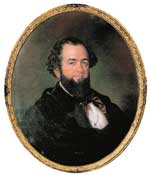 Edmund McIlhenny (1815-1890), was born and raised in Hagerstown, Maryland. His father was the owner of McIlhennys Tavern which sat on the northwest corner of the public square. The elder McIlhenny was also the mayor of Hagerstown. In 1841, allegedly after the death of his father and at the age of 26, Edmund moved to New Orleans. Edmund McIlhenny (1815-1890), was born and raised in Hagerstown, Maryland. His father was the owner of McIlhennys Tavern which sat on the northwest corner of the public square. The elder McIlhenny was also the mayor of Hagerstown. In 1841, allegedly after the death of his father and at the age of 26, Edmund moved to New Orleans.Edmund prospered after building five banks in New Orleans and began to hob knob with the wealthy of Crescent City where he eventually met Daniel Averys daughter, Mary Eliza Avery. Edmund had no farming experience prior to his marriage and settling on the Avery plantation. According to family legend, Edmund McIlhenny maintained a dislike for bland food. The influence of African, Caribbean, and Mexican cultures in the melting pot cuisine of New Orleans, in addition to the unique local preparations of the Acadians/Cajuns as well as the Spanish and French Creole populations in Louisiana, must have generated a crescendo of unique and interesting foods. The availability of fresh and exotic ingredients provided the adventurous epicurean with a playground of flavors and ideas. Making Tabasco red pepper sauce is a simple process requiring only three ingredients. All three ingredients were readily available on Avery Island: salt, cane sugar juice (vinegar), and tabasco chiles. Vinegar was prepared by fermenting the sugar cane grown on Petit Anse. From an 1881 article titled, "A Little World", in Scribner's Monthly, Volume XXII, by J. G. Holland: "Curiously enough, the chief industries at Petit Anse arise from the production and preparation of the three principal condiments which minister to the comfort of civilized man-pepper, sugar, and salt. A feature of these hilltops is the crop of red pepper, which seems to find a most congenial soil thus near the sun. A concentrated essence is prepared, put up, and sent to market from a small laboratory on the island..." Originally the method used was to ferment the ripe crushed red peppers with salt in stoneware jars; and later in discarded white oak barrels by tapping a hole in the barrel and covering the top of the barrel with rock salt to allow the peppers natural gases to escape without permitting air into the barrels. Salt was added regularly to the top of the barrel to further prevent oxygen from reaching the pepper mash. This process permitted the red peppers to naturally ferment without spoiling. When the natural fermentation stopped, the salt would form a hard crust over the top of the barrel. The barrels are stored for three years to properly complete the fermentation process.[22] Once the salt forms a hard crust, indicating the fermentation process is completed, the barrels are then opened and the bright red mash is removed for processing. The mash concentrate is pounded in a box and strained through a sieve, where the solids are set aside.[23] Vinegar is added to achieve the proper consistency of the finished sauce and then stirred/emulsified for a twenty-eight day period to reduce visible separation of solids and liquids. The resultant pepper sauce is then ready for bottling. On Avery Island, a McIlhenny secret recipe apparently exists, however, the real secret rests with the red Tabasco peppers being picked at the peak of ripeness[24], mashed, and then properly fermented, diluted with vinegar, and stirred at length. The secret is primarily the (lengthy) process, and where time is money; longevity of the manufacture and consistency of red pepper production with allowances for crop failures[25] has placed the McIlhenny Company in a unique position of total saturation of wholesale distribution and the inestimable goodwill of generations of repetitive sales of a timeless classic. Edmund McIlhenny originally wanted to call his concoction Petite Anse Sauce (after the salt dome which then was known as Isle Petite Anse). But when Avery family members balked at the commercial use of the family Island's name, he opted to use the name of the red peppers source and sought a trademark for improving his pepper sauce method. The Salt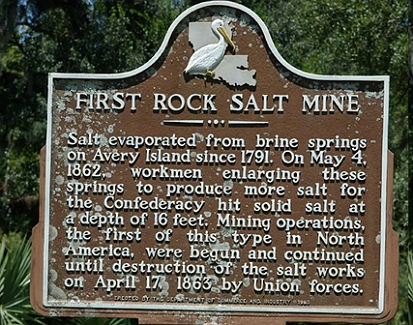 The Avery Island salt dome is one of five along the Louisiana Gulf Coast, formed when an ancient sea bed evaporated, depositing pure salt which erupted in large chunks and pushed the ground into a hill. Early native inhabitants knew of the massive salt dome, and during the Civil War, Union troops and Confederate soldiers fought in a tug of war over the precious natural resource. Because of the importance of this natural resource, rural Iberia Parish was a hotly contested area. The RubMcIlhenny's horticultural enterprise may have been interrupted by invading Union troops from captured New Orleans. Union troops invaded the island and captured the salt mines. In 1863 the McIlhenny and Avery families fled, abandoning the plantation to take refuge in Texas. The Union troops plundered Avery mansion and destroyed the plantation fields. The SpiceWhen the McIlhenny and Avery families returned to Avery Island in 1865, they found their plantation destroyed and their sugar cane fields in ruin. Allegedly a few volunteer chile plants still survived, providing enough seeds for Edmund McIlhenny to rebuild his pepper patch. However, historical fact and family legend are not exactly clear on whether Edmund began growing peppers before the Civil War or after he returned to the plantation. Whatever the case, gradually Edmunds yield of pods increased to the point where he could experiment with his sauce recipe in which ripened chiles were crushed into a mash with added rock salt, aged in stoneware jars and subsequently in fifty-gallon white oak barrels for three years and strained; where the resulting concentrate of pepper sauce was then mixed with vinegar. According to the Mcilhenny Company archives, in 1869 McIlhenny bottled his first batch of aged sauce in new cologne bottles with shaker spouts (not the 350 used cologne bottles as has been passed down as gospel) and then sent the bottles as samples to likely wholesalers. Allegedly, Edmund passed some of the sauce on to General Hazzard, the former federal administrator for the region, whose distant cousin E.C. Hazzard in New York City, was reputed to be the largest wholesale grocer in the United States. However this was accomplished, it is believed that McIlhenny Tabasco Sauce was distributed through E.C. Hazzards wholesale business. Described as a sauce from a new type of chili pepper and based on the strength of purchase orders that followed, Edmunds commercial enterprise began in 1869. According to McIlhenny Company historian and curator, Shane Bernard, PhD: "However, this somewhat romanticized tale, full of specific and colorful details that imply veracity, is largely untrue. We don't know for certain how Edmund McIlhenny obtained his original peppers. He never recorded the story for posterity, and his wife, brother-in-law, and children held diverse views on the subject, some mutually exclusive, said Dr. Bernard. In addition, 350 recycled cologne bottles containing Tabasco sauce were not sent to market in 1868. Rather, McIlhenny grew his first commercial crop in 1868, but sold no Tabasco sauce until 1869, when he sent 658 new cologne bottles filled with his condiment to market. And we know from McIlhennys meticulous business records that the domestic popularity of Tabasco sauce grew slowly over a decade or more, and didnt successfully export to Europe until the late 1870s." The legend continued that the sauce was so popular that orders poured in for thousands of bottles priced at one dollar each, wholesale, which was quite a bit of money in those days. However, distribution overseas did not occur as claimed, but many years later. In 1870, Edmund McIlhenny filed for a patent for an improvement in his pepper sauce. The improvement was the addition of an ounce of alcohol to every pound of residue which is then agitated and placed under a press, by which the remaining pulp and juice are forced out. This patent was subsequently allowed to expire as Edmund determined that there was no improvement to his Tabasco Sauce with the addition of alcohol. 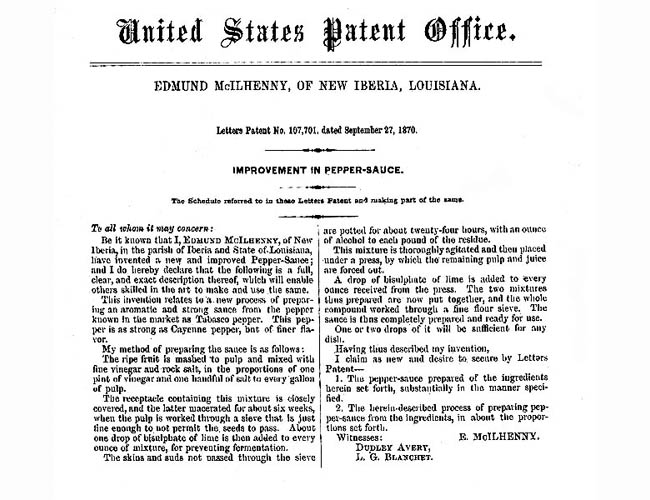 After Congress passed the 1905 Federal Registration of Trademarks Used in Commerce between States Act, marks in exclusive lawful use for the ten years preceding the enactment of the statute were entitled to registration. Numerous challenges to the use of the trademark were waged in the late 1890s and early 1900s, including B.F. Trappey & Sons Tabasco Pepper Sauce, Ed Bulliards Evangeline Tabasco Sauce, H.J. Heinz Company, and the Campbell Soup Company; although third party infringement of the Tabasco trademark was unlawful. 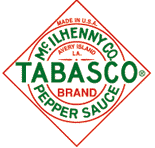 Subsequently, a 1920 U.S. District Court for the Western District of Louisiana decision confirmed that the McIlhenney Company was the exclusive lawful user of the TABASCOtrademark where the McIlhenny Company was the single source of the product, and therefore, the trademark had acquired secondary meaning as a result of the publics association of Tabasco with the McIlhenny Company and entitled to registration under the 1905 Act. Addressing the origin of the Tabasco name, the McIlhenny Company Pepperfest website History Tent question and answer section responds to the following: Might Maunsel White's and Edmund McIlhenny's peppers been of the same variety?"Although it's possible that White's and McIlhenny's peppers were the same variety, it's also equally possible that their peppers were different varieties of red pepper that merely bore similar names (or different spellings of the same name). It is known, for example, that the words "tobasco/tabasco" were used as geographically descriptive terms in the antebellum period to refer to peppers thought to hail from the Tabasco region of Mexico, and that the words did not necessarily refer to one variety. Moreover, during the early 1800s a spice was exported in large quantities from Mexico and was referred to geographically as "tabasco," even though the spice in question was obtained from the berry of the myrtle tree (indigenous to the Tabasco region of Mexico), and not made from capsicum peppers at all. (This spice is now known in the market as "allspice.") Thus, the geographic terms "tobasco/tabasco" were used quite loosely during the antebellum period. Later, in 1888, Edmund McIlhenny's pepper was officially recognized by a noted American botanist and is now classified as Capsicum frutescens var. tabasco." Jean Andrews, author of Peppers, The Domesticated Capsicums, writes: "In 1847 the inland town of Tabasco on the banks of the Tabasco River (now Grijalva) in the territory by that name south of the state of Veracruz, Mexico, was second to the port of Veracruz in commercial importance on the Gulf of Mexico (Ghigliazza 1948, 59). Commerce with Mexican ports was commonplace because the bustling port of New Orleans was a city with strong ties to Mexico dating from the period of Spanish dominion, which lasted until 1801. The place name Tabasco was current in New Orleans in the late 1840s, not only because of the established trade but also because New Orleans played an important role in the war with Mexico (1846-1847). It is the major staging point as well as the closest large U.S. port where the sick and injured Americans engaged in conflict could be brought for treatment and recuperation (Bauer 1974, 388)." Edmund McIlhenny sold his first bottles of Tabasco Sauce in 1869, ten years after Maunsel Whites first commercial bottle was sold in 1859; although this date is disputed by the McIlhenny Company. The McIlhenny Company alleges that Whites concoction was first commercially sold in 1864, only five years before the first bottle of Tabasco sauce was sold. However, pursuant to the McIlhenny Companys acknowledgement, the undisputed fact remains that Maunsel Whites Concentrated Extract of Tobasco Sauce was the original hot pepper sauce made with tobasco/tabasco chiles and the first sold commercially in the United States. The Earliest Bottled Chile Pepper Sauces in the United StatesThe following research is excerpted from The Hot Sauce Bible, by Dave DeWitt & Chuck Evans, The Crossing Press (1996): "Much of what we know about now-extinct brands of hot sauces comes from bottle collectors. There is not a great body of material on the subject of collectible hot sauce bottles, but we are indebted to Betty Zumwalt, author of Ketchup, Pickles, Sauces: 19th Century Food in Glass, who dutifully catalogued obscure hot sauce bottles found by collectors. Many bottles in the hands of collectors were uncovered from archaeological digs and shipwrecks. Other sources of information about early hot sauces are city directories, which often contained advertisements for sauces, and newspapers. We know from these sources that the first bottled cayenne sauces appeared in Massachusetts around 1807. These were probably homemade and similar to the English sauces with the silver labels. Sometime between 1840 and 1860, J. McCollick & Company of New York City produced a Bird Pepper Sauce in a large cathedral bottle that was nearly eleven inches tall! This sauce is significant because it was probably made with the wild chiles called chiltepins or bird peppers. We also know that in 1849, England's Lea and Perrins Worcestershire Sauce was first imported into the United States via the port of New York. That year was also important in the history of hot sauces because it marked the first recorded crop of tabasco chiles, the vital ingredient of McIlhenny Company's Tabasco Pepper Sauce. That crop was grown by a prominent Louisiana banker and legislator, Colonel Maunsell White on his Deer Range Plantation. Colonel White manufactured the first hot sauce from the "Tobasco" chiles and advertised bottles of it for sale in 1859. About this time, he gave some chiles and his sauce recipe to a friend, Edmund McIlhenny, who promptly planted the seeds on his plantation on Avery Island. This author notes that the McIlhenny 1870 Patent for Improvement in Pepper-Sauce records a new process of preparing an aromatic and strong sauce from the pepper known in the market as Tabasco. This pepper is as strong as Cayenne pepper, but of finer flavor. The Patent expressly names the Cayenne pepper[26], a variety of Capsicum var. Annuum, which was an established chile pepper variety available to consumers in the antebellum period.[27] Cayenne/Bird Pepper Sauces appear to be the original bottled hot pepper sauces in the United States. Evidence that Cayenne[28] Pepper Sauces continued to be produced and bottled around the beginning of McIlhennys Tabasco sauce have been reported from several sources. Excerpted from THE HOT SAUCE BIBLE, by Dave DeWitt & Chuck Evans, The Crossing Press (1996), research found: "From an excavated wreck of the good ship Bertrand, dated 1874, we know that Western Spice Mills of St. Louis was making hot sauce around that time because 173 of their bottles were uncovered. That same year (some say 1875), Eugene R. Durkee of Brooklyn, New York, applied for a patent on a hexagonally-shaped "Chilli Sauce" bottle. Although the patent application survives, no actual bottle has ever been found, but E.R. Durkee & Company became a rather large spice and condiment company and the brand name exists to this day. Around this same time, W.K. Lewis & Co. in Boston was producing a pepper sauce in a square cathedral-shaped bottle. In 1877, William H. Railton, a Chicago businessman who owned the Chicago Preserving Works, began using a maltese cross-shaped label for table sauces "prepared from a Mexican formula." He applied for a trademark in 1883, and by 1884 he was buying large ads for his Chili Colorow Sauce. Interestingly enough, although it was a "chili" sauce, the advertising copy claimed: "It is expressly suitable for family dining, possessing a fine, rich body of exquisite flavor and has neither the fiery nor nauseous taste which characterizes most sauces." With a typical nineteenth century patent medicine pitch, the copy went on to claim: "It relieves indigestion and cures dyspepsia. Physicians recommend it highly." During the 1880s and '90s, several hot sauces sprang up, including C&D Peppersauce, manufactured by Chace and Duncan in New York City in 1883, but we have nothing left but the bottle. Sometime around 1900, the Bergman and Company Pioneer Pickle Factory in Sacramento, California, began selling Bergman's Diablo Pepper Sauce in five-inch tall bottles with narrow necks that resembled the typical hot sauce bottle of today." The Proof is NOT ONLY IN the Bottle . . . the Proof IS the Bottle!Meat was a valuable commodity and little went to waste. Where there was no refrigeration; early pioneers, settlers, and farmers preserved meat, game, venison, and fowl through drying, curing, pickling, and smoking methods. When meat products were not consumed promptly, the perfectly edible fresh "kill" would become slightly tainted. Spices, relishes, catsups, meat sauces, mustards, and pepper sauces were commonly used to mask the odor of tainted meat. The consumer became acquainted with condiments at the general mercantile stores. The importance of condiments is reflected in the marketing of these premium products which occurred almost exclusively at the point of sale. In order to stand out on the burgeoning market shelves, fanciful glass bottles were manufactured to advertise the container's contents. The spice, condiment, and pickling companies often patented the distinctive look of their condiment bottles to differentiate their product from the competition. Peppersauce bottles have been found, excavated, and uncovered intact in shipwrecks, factories, and trash dumps by bottle diggers/collectors and archaeologists.[29] Pre-Civil War evidence consists of empontiled and molded peppersauce bottles. Reconstruction-era hand blown in-mold embossed peppersauce bottles include a variety of gothic cathedral bottles. These early ornate pepper sauce bottles were created in a variety of colors, including: aqua. teal, various shades of green including dark green, purple/amethyst, and cobalt blue. Clear glass, being the least expensive, was therefore the most common. This author's extensive collection includes several early pepper sauce bottles with wide-open jagged pontile scars. Pontiles, which are blowpipe affixed glass rods, are used to hold the bottle steady during the shearing process and application of a glass top where the bottle would be snapped off the rod leaving a distinctive clean or jagged mark, or scar. In the post-Civil War Reconstruction period, hollow metal punty or "puntee" rods replaced glass pontiles. Hand blown glass bottles, whittle mold, spiral designed, petal bottom, ribbed, ridged, paneled, ornate, bell-shaped, square-ridged, and smaller colorful sample-size peppersauce bottles in this author's collection date from the 1840s-1900s. The growth of pepper sauce manufacturers (and the resultant corresponding growth of peppersauce bottles) began in the late 1860s-1870s and became widespread up through the turn of the century. Early bottle labels included embossing of the bottle itself and sparsely used lead labels applied to cathedral peppersauce panels, including one found on a circa 1851-1860 William H. Davis Pepper sauce bottle, however, costly lead labels eventually gave way to considerably less expensive paper labels. Excellent examples of large cathedral peppersauce bottles with lead labels are highly sought after by bottle collectors; most often selling for more than a thousand dollars each. Early embossed hand blown mold pepper sauce bottles in the author's collection include: several spiral designed bottles patented by E. R. Durkee & Company; many varieties of colored spiral bottles with Stickney & Poor (S&P) embossed on the base; a multiple-paneled William Schotten & Co. St. Louis (Wm. S & Co.) embossed pepper sauce bottle; a clear spiral design McIlhenny Tabasco Sauce bottle, as well as a rare barrel-shaped McIlhenny Tabasco Sauce bottle along with other embossed McIlhenny & Co., Avery Island Tabasco Pepper Sauce bottles; an early open-pontiled Wells Miller & Provost (W. M. & P. N.Y.) embossed pepper sauce bottle; a small bulbous embossed Trappey's pepper sauce bottle; an embossed Evangeline Pepper Sauce Made in St. Martinville, LA USA pepper sauce bottle; several different embossed pepper sauce bottles from the Horseshoe PickleWorks Ltd. of New Orleans; an embossed Jumbo Brand Pepper Sauce The Frank Tea & Spice Co. Cincinnati, O. bottle; and many other late 1800s examples with little or no embossing. Examples from the Chas E. Erath Manufacturing Company of New Orleans, produced circa 1880-1890, include two pepper sauce bottles embossed: EXTRACT OF LOUISIANA PEPPER CHAS. E. ERATH NEW ORLEANS and CHAS. E. ERATH MFR. OF RED HOT CREOLE PEPPER SAUCE, CATSUP CREOLE OYSTER COCKTAIL SAUCE AND MUSTARD NEW ORLEANS, LA. This author's collection includes embossed bottles manufactured after the automatic bottle machine (ABM) was introduced in 1903 and many varieties of early pepper sauce bottles with paper labels (in various stages of deterioration). Consequently, as a result of automation in the industrial age, glass bottles manufactured in one operational process eventually captured the market between 1910 and the Roaring 20's.
In the latter part of the nineteenth century and in the early part of the twentieth century, rural Iberia Parish was home to the McIlhenny Company; B.F. Trappey & Sons (a former McIlhenny employee) who began manufacturing Louisiana Hot Sauce, Red Devil Cayenne Pepper Sauce and Bull Louisiana Hot Sauce in 1898; and Franks Original RedHot Cayenne Pepper Sauce where pepper farmer Adam Estilette partnered with Jacob Frank in New Iberia in 1920. Other early South Central Louisiana hot sauce makers include: the Bulliard familys Evangeline Tabasco Sauce in 1910; Baumer Foods Crystal Hot Sauce in 1923; and Bruce Foods Original Louisiana Brand Hot Sauces in 1928. The Gebhardt Chili Powder Company of San Antonio, Texas described their Gebhardts Eagle Tabasco Sauce as . . . a delightful relish and exquisite flavor to meats, soups, fish, gravies, etc., and is a material aid to good digestion. A few drops are all that are necessary. Gebhardt's 1911 Mexican Cooking brochure (Price 15 Cents) pictures their labeled bottle fitted with a metal shaker top. The description continues: In the manufacture of Gebhardts Eagle Tabasco Sauce we use only the pure extract of the finest Tabasco peppers, which are grown especially for us in the State of Tabasco, Mexico.[30] The same or similar method(s) used to produce a Cayenne Sauce was used by White and McIlhenny to produce their tobasco/tabasco pepper sauces. The only difference was the variety of chile pepper used to make the sauce product.[31] Where Maunsel Whites Concentrated Extract of Tobasco Sauce may have first been made available around 1850 and commercially in 1859; and where McIlhennys Tabasco Sauce was commercially available in 1869, this author believes that it is probable that both Maunsel White and Edmund McIlhenny developed their distinct tobasco and tabasco red pepper sauce recipes, respectively, from the original Cayenne pepper sauce crafters of the early-to-middle 1800s. This author has a color photocopy of the earliest known handwritten invoice for pepper sauce sold commercially. The October 19, 1835 Stickney & Poor invoice to customer Silas Pierce lists 21 Pepper Sauce bottles purchased at a wholesale cost of $1.00 per bottle. Stickney & Poor Spice Company historian, Owen Mathewson, provided several additional Stickney & Poor invoices for comparison. Located on Chatham Street (and later listed on Chatham Row) in Boston, Massachusetts, Stickney & Poor's invoice heading describes itself as "Manufacturers of and Dealers in Mustard, Yeast Powder, Pepper Sauce, Coffee, Spices, & C." Mr. Mathewson described an 1875 newspaper advertisement that Charles L. Stickney was established in New York City in 1815 and listed in business directories as a mustard manufacturer in 1835. Interestingly, another New York City pepper sauce was being bottled, estimated circa 1830-1840s, by Wells Miller & Provost No. 217 Front Street New York, which label information was embossed on an identical glass bottle to Stickney & Poor's pepper sauce bottle. It is likely that the same glass bottle manufacturer produced the bottles. During the 1870-1880s, it appears from the use of identical pepper sauce bottles (other than embossing), that the E.R. Durkee Company in New York and Stickney & Poor Spice Company in Boston became great rivals. Physical evidence exists in the variety of hand blown glass pepper sauce bottles where glass lips, bands, blobs, tapers, and early collars were crudely applied at the top of the mold seams of the bottle to the neck of the bottles. However, documentation about early pepper sauce manufacturing pioneers is nearly non-existent; a historical record that may very well be lost to the ages. ![[image]](http://www.archaeology.org/online/news/thumbnails/tabasco2.gif) ![[image]](http://www.archaeology.org/online/news/thumbnails/tabasco2.gif) ![[image]](http://www.archaeology.org/online/news/thumbnails/tabasco2.gif) [1] Pictorial Field-Book of the War of 1812, Benson J. Lossing (1869). [2] The Battle of New Orleans, Andrew Jackson And Americas First Military Victory, Robert V. Remini, Viking Press (1999). The Pictorial Field-Book of the War of 1812 indicates the battalion numbered three hundred and eighty-five men composed of 4 companies: Hulans, or foot dragoons, under Captain St. Genre; Francs, Captain Hudry; Louisiana Blues, Captain Maunsel White; and Chasseurs, Captain Gilbert. [3] Records of Ante-Bellum Southern Plantations From the Revolution Through the Civil War Series J: Selections from the Southern Historical Collection Part 5: Louisiana, University Publications of America (1996). [4] The Cabildo, Two Hundred Years of Louisiana History, Louisiana State Museum. [5] 1851 New Orleans City Directory, Louisiana Division, Main Branch New Orleans Public Library. [6] New Orleans Public Library-Crescent City Memory Collection. [7] Dyas Collection-John Coffee Papers, Department of Tennessee State Library & Archives. [8] The Advocate: Capitol Castle, article by Carol Anne Blitzer, Baton Rouge, Louisiana. [9] Named La Villa Rica de la Vera Cruz, The Rich Town of the True Cross, the sea port was founded by Hernn Corts, who first landed there in 1519 at the start of his quest to conquer Mexico for Spain. [10] McIlhenny Company coincidentally advertised its powerful pepper seasoning Tabasco Sauce under the slogan ONE DROP WORKS WONDERS. The McIlhenny Company could have been referring to the fine flavor or even the alleged therapeutic qualities where the packaging also reports: TABASCO sauce is a perfectly healthy seasoning. [11] PEPPERS, The Domesticated Capsicums, Jean Andrews, University of Texas Press (1984). [12] The word tobasco/tabasco was erroneously translated to mean land where the soil is humid. Tapach-co {the suffix co meaning place of} is the etymological derivation of the Nhautl word tapachtl meaning coral or (oyster) shell which is the description provided Hernn Cortez in 1519 by the Nhuatl-speaking natives to describe the place of coral or oyster shell. Diccinario de la Lengua Nahuatl O Mexicana, Rmi Simon, Siglo Veintiuno Editores, SA de CV (1988). See also PEPPERS, The Domesticated Capsicums, Jean Andrews, University of Texas Press (1984). [13] Petit Anse translates from French meaning Small Bay. [14] Avery Family of Louisiana Papers Inventory (#M-3289)at the Manuscripts Department of the University of North Carolina at Chapel Hill. [15] Pepper Seeds of Fortune, C. Richard Cotton, American Profile (February 11, 2001). [16] Column, Reminiscing: Was Col. Maunsel White the True Originator of Tabasco Sauce?, Metropolitan New-Enterprise (July 15, 2004). [17] Column, Reminiscing: Was Col. Maunsel White the True Originator of Tabasco Sauce?, Metropolitan New-Enterprise (July 15, 2004). [18] Times Picayune, January 10, 1977. [19] Maunsel White has been reported from several different sources to have died in 1862 or 1863. This author believes that White died in 1863. See Inventory of the Maunsel White Papers, 1802-1912, Collection Number 2234, at the Manuscripts Department of the University of North Carolina at Chapel Hill. [20] Cypress Grove Cemetery became the first cemetery built to honor New Orleans volunteer firemen and their families. It was made possible in 1838 by New Orleans philanthropist Stephen Henderson whose estate left property to the Firemens Charitable & Benevolent Association. The charitable association sold this property to fund the purchase of the cemetery site at the end of Canal Street and the former banks of Bayou Metairie. [21] Maunsell White, Jr. often spelled his name with a double L, most likely to differentiate himself from his father. [22] There is no conclusive evidence that the use of white oak barrels, aged or new, for putting up mash enhances the fermentation process. The original utilization of used oak barrels was likely due to the availability of an easily obtainable, inexpensive, and sturdy storage container for larger quantities of product. [23] The solids are used for other products, or sold, and constitute a separate profit center. [24] Tabasco peppers were gauged ripe enough to pick by visual comparison of the red peppers in the field to a stick painted the appropriate color of red, i.e., a red stick or baton rouge. [25] Capsicum frutescens var. tabasco is highly susceptible to an etch wilt disease, which often causes large crop failures. PEPPERS, The Domesticated Capsicums, Jean Andrews, University of Texas Press (1984). [26] The Cayenne pepper variety was also known as a Bird Pepper in the 1800s. [27] With a heat level of 30,000-50,000 Scoville heat units, the Tabasco chile pepper is commensurate to the Cayenne chile pepper on the Scoville Heat Scale, a subjective taste test further refined by the use of HPLC (High Performance Liquid Chromatography). [28] A pre-Colombian chile cultivar, the word Cayenne derives the native Brazilian Tupi language family. Cayenne is also the name of the river that runs through French Guiana as well as the name of the capital of French Guiana. However, Cayenne chiles are no longer cultivated in South America. New Mexico, Louisiana, Mexico, Africa, India, and Japan grow the pepper known as milchilli and described as being long, narrow, ending in a sharp point. Red when ripe and sown and reaped in corn season. {Quoting Fray Herndez, Nova plantarum, animalium et mineralium Mexicanorum Historia, rerum medicarum novae (1651). Translated into Latin from 1628 edition by A. Reccho, Rome and cited in PEPPERS, The Domesticated Capsicums, Jean Andrews, University of Texas Press (1984).} [29] See Ketchup, Pickles, Sauces: 19th Century Food in Glass, Betty Zumwalt, West Group Publishing (1980). [30] Mexican Cooking, The Flavor of the 29th Century. . .That Real Mexican Tang, Copyright 1911 by The Gebhardt Chili Powder Co. [31] Cayenne is classified as Capsicum annuum var. annuum Cayenne and Tabasco is classified as Capsicum frutescens var. tabasco. |
|
|
Export date: Fri Apr 25 5:15:31 2025 / +0000 GMT This page was exported from Chuck Evans' MONTEZUMA Brand Sauces & Salsas [ http://montezumabrand.com ] Export of Post and Page has been powered by [ Universal Post Manager ] plugin from www.ProfProjects.com |
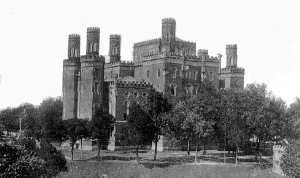 Old State House Baton Rouge, ca. 1880
Old State House Baton Rouge, ca. 1880